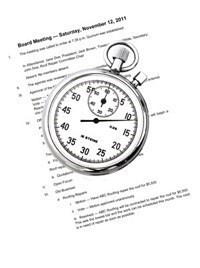
In Bolton, Massachusetts, a condo resident owned a truck with commercial license plates and, when it wasn’t in use, he wanted to park it on the property. The previous board gave him approval to do so, but when it came time to produce proof of this decision to the new board, the resident couldn’t produce copies of the meeting minutes. At another association, confusion over a decision about the size of dogs that are allowed on the property was solved when a board member produced copies of the minutes—which proved that the vote was to allow dogs weighing less than 35 pounds, not 50 pounds.
Associations are run by boards and, of course, boards hold meetings. The meetings are important, but these two scenarios prove that keeping good records of what goes on in those meetings is just as important. Not only can copies of the minutes come in handy when decisions that were made at these meetings are forgotten, but it can come in handy at others times, too.
One of the reasons for keeping minutes is to have an official record of corporate decisions that have been made in these meetings. “The board members and property managers don’t always remember what they decided,” notes says Diane Rubin, principal at the law firm of Prince Lobel Tye, LLP in Boston. “For the unit owners, it’s also important to have a record of decisions that were made. And, finally, sometimes at a time of purchase, a potential owner also wants to look at the minutes. It’s a good place to start to get a snapshot into the health of the association.”
Minutes 101
Thanks to today’s technology, minutes don’t have to be taken with pen and paper. Instead, an iPad or laptop can be used to document the minutes. Surprisingly, James Butler, executive manager of J. Butler Property Management in Tewksbury, Massachusetts, says that probably 75% of boards are still writing out their minutes while others are using laptops or iPads. Nobody that he knows of is videotaping meetings.
The secretary’s main function is to record minutes and keep copies of the records, but Rubin says that in a larger association, the property manager can also take the minutes. Taking proper and complete minutes at a meeting may seem pretty easy and self-explanatory—just write down what’s said and who said it—but there’s more to it than that. Think of taking minutes as taking notes when you were back in class. You didn’t write down every thought, comment and discussion you had in class. You simply wrote down the facts and some other information, but not everything. Condo association minutes can be treated almost the same way.
“I always tell my board that it’s minutes not hours. Don’t put down all the little details,” says Patrick Brady, a partner at the law firm of Marcus, Errico, Emmer & Brooks, P.C. in Braintree, Massachusetts. “We have to remember that the minutes are a record of what was done at the meeting, not what was said by the attendees.”
What information do you include and how much? Who takes and approves the minutes? What happens with them after they are written? And you might not realize that writing too much, or too little, of what’s been said, can cause hefty problems later.
“It can be dangerous to not include enough information,” says Butler. “Leaving things out that are pertinent to the association and that people are supposed to know about can put the association and board in liability because you’re not being transparent with the rest of the unit owners. Board members are meant to act in a fiduciary responsibility and represent unit owners in a fiduciary responsibility.”
Brady says that the minutes should include details such as the date, time and place of the meeting. “If the trustees are meeting at the clubhouse, library or VFW, you’ll want that in there,” he says.
It’s also important to include any motions that were discussed and voted on. “There should be specific wording of the motion and any amendments and secondary motions and you can simply list the discussion and then the vote,” says Brady. “For example, a unit owner requested to plant in front of their unit, so you would include how many plants were approved. In this case, a year later it was questioned how many plants were approved. If the minutes were approved in the next meeting that’s what you look at to see what decision was made.”
If the board votes on a contract or decision to buy something, documenting that decision commits the association to a financial commitment and course of action. “You don’t want to go into pages of detail, but minutes should create a record of how much we approved,” says Rubin.
She adds that taking minutes is pretty straightforward and almost parallels the agenda, but things such as personal opinions or withdrawn motions shouldn’t be included. “Any verbatim discussion about points of view on a matter can actually distract from the matter.”
After the Fact
Once the meeting is done, the minutes should be typed up, signed – usually by the clerk or secretary – and distributed to the board for review. At the next meeting, the minutes are reviewed and approved. At that point, the minutes are final and can be distributed to unit owners.
“In Massachusetts, unit owners have a right, under the Massachusetts Condominium Act, to inspect and review the minutes,” says Brady. “The association is free to distribute them however their policies are. They can put them on the website or post minutes on the bulletin board.”
Occasionally what’s in the draft of the minutes is disputed by a board member or trustee before they are approved. “If there’s a disagreement about what happened after the minutes are written, the board should go back and work through that point of agreement,” says Rubin. “I haven’t seen instances where people have disagreements that can’t be resolved.”
Butler says that sometimes minutes can even be misunderstood. “At a meeting, there was discussion about water getting into the basement of one of the unit owners,” he says. “It was noted briefly in the minutes, but residents thought that everybody needed work done on foundation of basements. In another case, we replaced decks, but only did half of them. We received a letter asking us why we weren’t doing the other half. In this case, the first half of decks was in much worse condition than the other side of the property. Someone who read the minutes thought there was favoritism going on, but it was a misunderstanding.”
Brady says that Massachusetts law requires that records be kept for seven years, but how the board stores those records varies association by association. “I generally recommend the easiest way to keep minutes is with a three-ring binder,” says Brady. “However, I think it’s fantastic that once handwritten minutes are approved and typed up, they can also be scanned in and made available online to the unit owners on the website or by email.”
Rubin says that the Statute of Limitations on causes of action for contracts is six years, but she would recommend keeping copies of minutes much longer, especially if they are stored electronically. “I work with associations where someone has asked to go back 10 years ago to see what was decided on, so it’s important to store them,” she says.
Butler says that his associations do not get rid of them. “There’s a history there and you can go back and see the paper trail of a decision,” he says.
“It’s an extremely valuable tool for associations, even for small ones,” says Rubin. “I encourage people, who might be buying a condo unit to get six months of condo minutes. You can have a better sense of what you’re buying.”
If your board would like to learn how to keep better minutes or need a refresher course on what to include and not include, there are resources to help.
Those resources include the Community Associations Institute (CAI), which has three chapters in New England, and offers courses on a variety of management and board operations topics. Visit www.caionline.org to learn more about CAI and to access its bookstore filled with community association-related publications.
There’s no need today for boards to operate in the dark when it comes to keeping good meeting minutes. “You can get templates online,” says Butler. “There’s an outline of what you’re supposed to do, how to end the meeting, call it to order, how to review the minutes and close it out and prepare for the next meeting.”
Lisa Iannucci is a freelance writer and a frequent contributor to New England Condominium.






Leave a Comment